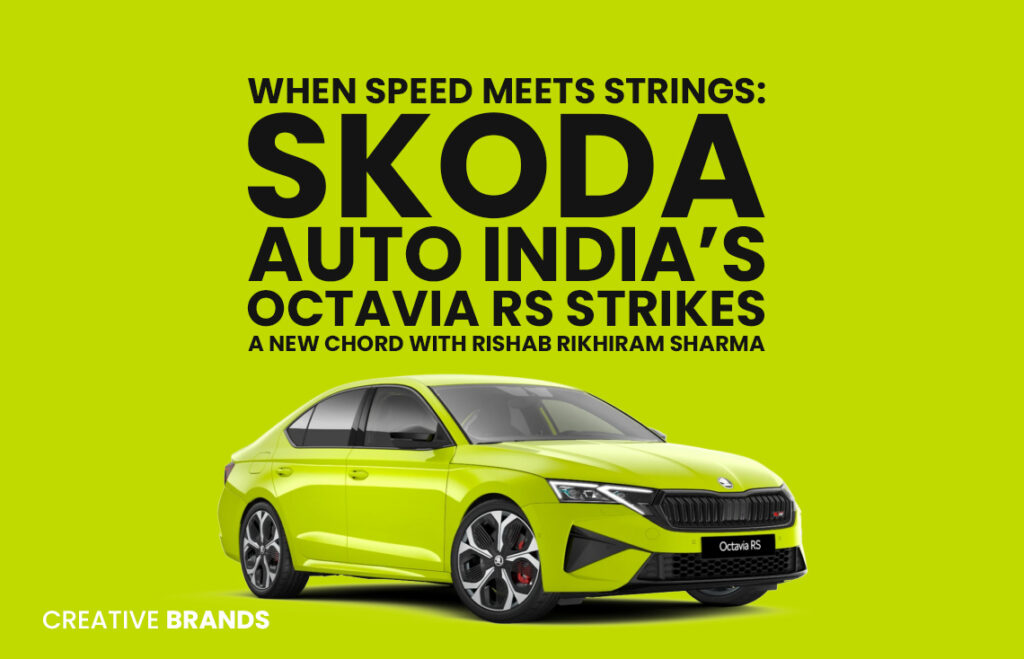Škoda Auto India’s new film pairs the Octavia RS with sitarist Rishab Rikhiram Sharma, blending automotive engineering with Indian classical rhythm. Portraying speed as harmony rather than noise, the campaign celebrates performance, culture, and creativity — uniting tradition and technology in a distinctly Indian yet globally resonant storytelling experience.

Škoda Auto India has unveiled a campaign that redefines the language of performance — one that speaks not through the roar of an engine but through the melody of a sitar. In a striking creative move, the brand has brought together the Octavia RS, a symbol of European engineering precision, with Rishab Rikhiram Sharma, the acclaimed young sitarist known for fusing Indian classical music with modern soundscapes.
The film positions speed as rhythm, not noise — turning motion into music and performance into poetry. Against the hum of the highway, the resonance of Sharma’s sitar strings blends seamlessly with the pulse of the Octavia RS, crafting a harmony that feels both powerful and peaceful. The result is a cinematic experience where engineering and artistry flow as one, capturing the essence of modern India’s dual identity — rooted in tradition, yet racing ahead with innovation.
In just a few frames, Škoda manages to translate horsepower into heartbeat. The campaign avoids the clichés of speed and power; instead, it interprets movement as an emotion — a journey that mirrors the tempo of life itself. The Octavia RS glides across the screen not as a machine, but as a partner in performance, matching the sitar’s pace, precision, and grace.
Rishab Rikhiram Sharma, who represents a new generation of musicians bridging classical Indian sounds with global influences, becomes the perfect counterpart. His music, both timeless and contemporary, reflects the same balance that Škoda aims to achieve in its cars — tradition meeting technology, artistry meeting engineering.
The collaboration stands out for its cultural depth. By choosing the sitar — an instrument deeply associated with India’s musical heritage — Škoda’s creative narrative roots itself firmly in the Indian ethos. Yet the treatment, tone, and aesthetic are global, reflecting a confidence in telling Indian stories for the world stage.
It’s not just an ad; it’s an expression of cultural design thinking — how two seemingly distinct worlds can resonate when brought together with sensitivity and imagination. The film visually choreographs the interplay between Sharma’s hands and the car’s gear shifts, between musical tempo and driving rhythm, symbolising how mastery in art and engineering both demand precision, control, and soul.
In recent years, automotive marketing has shifted from pure performance to emotional storytelling. Brands are increasingly focusing on what cars mean rather than what they do. Škoda’s new campaign fits perfectly into this narrative evolution. It tells a story about rhythm, not race — about the meditative beauty of motion rather than the adrenaline rush of speed.
The choice of Rishab Rikhiram Sharma is also inspired. Coming from the renowned Rikhiram musical lineage — which has crafted instruments for legends like Ravi Shankar and George Harrison — Rishab embodies legacy and innovation in equal measure. His collaborations often blend Hindustani classical music with electronic, ambient, and global genres, making him an artist who bridges past and future effortlessly.
That is precisely what Škoda’s Octavia RS stands for in India — a car that brings European engineering to Indian roads without losing its global elegance. In the film, the car’s sleek design and fluid movement become visual metaphors for musical phrasing — dynamic, expressive, and meticulously crafted.
From a branding perspective, this collaboration underscores Škoda Auto India’s evolving creative identity — one that embraces cultural authenticity while highlighting contemporary craftsmanship. Rather than relying on loud power statements, the brand speaks in tones of refinement, intellect, and emotion. The underlying message is clear: true performance is not just about acceleration; it’s about balance, control, and harmony.
The visuals are lush yet minimalistic. The film opens with Rishab tuning his sitar, fingers brushing over the strings as sunlight filters through. Cut to the Octavia RS — its engine starting with a hum that blends almost indistinguishably with the instrument’s opening note. As the car accelerates, the sitar takes over, each strum reflecting a gear shift, each curve in the road echoing the arc of melody. The final frame — Rishab’s serene expression mirrored by the car’s poised stillness — ties the concept together in perfect sync.
It’s the kind of campaign that feels less like an advertisement and more like a visual raga — a short symphony of sound, design, and identity.
For Škoda, this isn’t just about selling a car; it’s about positioning performance as culture. In a world where automotive brands compete on features and horsepower, Škoda’s decision to connect its flagship model to an Indian art form signals a deeper understanding of today’s consumer — one that values meaning as much as mechanics.
The campaign also highlights how global brands are increasingly localising their storytelling to resonate with Indian audiences. By celebrating Indian artistry in a modern frame, Škoda not only builds emotional relevance but also contributes to a larger cultural conversation about the fusion of heritage and progress.
As the film closes, the music fades, leaving behind the gentle hum of the car’s engine — a reminder that rhythm exists in all motion, whether it’s a note plucked on a string or a wheel turning on asphalt.
In bringing Rishab Rikhiram Sharma and the Octavia RS together, Škoda Auto India has crafted a narrative that goes beyond advertising — one that plays on the strings of emotion, pride, and artistry. It’s a symphony of speed and soul — where performance finds its rhythm, and tradition finds its drive.
Discover more from Creative Brands
Subscribe to get the latest posts sent to your email.






